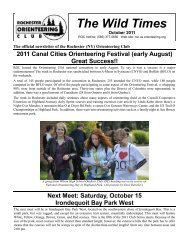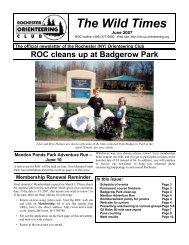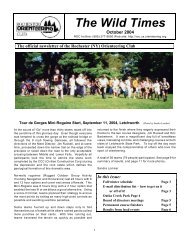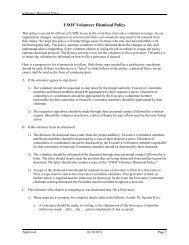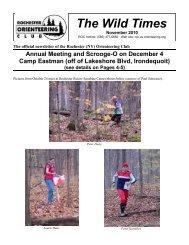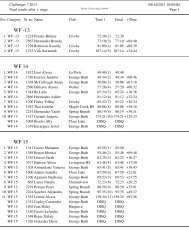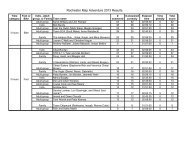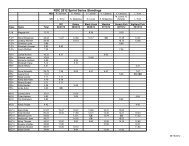Rogaine Beginner's Guide â Top Ten Tips
Rogaine Beginner's Guide â Top Ten Tips
Rogaine Beginner's Guide â Top Ten Tips
Create successful ePaper yourself
Turn your PDF publications into a flip-book with our unique Google optimized e-Paper software.
<strong>Rogaine</strong> Beginner’s <strong>Guide</strong> – <strong>Top</strong> <strong>Ten</strong> <strong>Tips</strong><br />
John Godino and John Bartholomew, CROC<br />
Are you thinking about trying your first <strong>Rogaine</strong> but not sure if it’s for you<br />
Hopefully these suggestions will encourage you to take the plunge, demystify the<br />
experience, and ultimately suffer just a little bit less. I’m a beginning <strong>Rogaine</strong>r<br />
myself, competing in several of the “Big Muddy” <strong>Rogaine</strong>s sponsored by the<br />
Columbia River Orienteering Club (CROC), held in central Oregon over the last few<br />
years. There is something in the absolute bizarreness of this event just grabs me on<br />
a gut level. (It’s also fun to see the expression on people's faces when they<br />
innocently ask you, “So, what did you do this last weekend”, and then you tell them<br />
=^)<br />
There are many more experienced <strong>Rogaine</strong>r’s out there than I, and I'm sure their<br />
ideas may well be better than mine. If you know someone who is done a <strong>Rogaine</strong> or<br />
an adventure race with a navigation component, try to get a few tips from them as<br />
well. Part of the sport is “paying your dues”, and suffering through an event or two<br />
in order to discover for yourself what works and what doesn't. I do have some<br />
concerns that I’m giving away too much, and that doing so takes some of the<br />
mystique out of the event. But in the end, I decided to share.<br />
The ideas below are from my own <strong>Rogaine</strong> Journal, a sort of rambling account that<br />
I've kept after each event of what worked, what didn't, and what I would do<br />
differently next time. Various web searches trying to find information like this have<br />
turned up nothing worthwhile, so in the spirit of the Internet, I put it out there for<br />
your use. I hope you find it useful, and that some of the information here inspires<br />
you to go try this wacky sport for yourself.<br />
A final word of advice . . . enjoy the moments you're out there. Hear the nighttime<br />
call of the owls and the dawn warble of the meadowlarks, be mesmerized by the<br />
wind’s rhythmic ripple in the tall spring grasses, take a moment to look into the<br />
center of the blooming wildflowers, admire the deer antler you found next to the<br />
water hole. A <strong>Rogaine</strong> is a unique experience and usually in a special landscape few<br />
people will ever see, let alone over an entire day and night. Remember and hold<br />
these small moments and memories, and you may find years later they are the most<br />
special.<br />
“Rogaining is 14 hours of fun followed by 10 hours of character enhancement.”<br />
Big Muddy race organizer Mal Harding<br />
And remember: It doesn't have to be fun . . . to be fun.<br />
Happy <strong>Rogaine</strong> adventures,<br />
John Godino<br />
Portland, Oregon<br />
1. Training<br />
2. Map prep<br />
3. Route planning<br />
1
4. Foot care<br />
5. Food and hydration<br />
6. What’s in your pack<br />
7. General Navigation<br />
8. Pace counting<br />
9. Keeping the Mental Mojo<br />
10. Night O, Lighting, and the Secret Weapon<br />
Training for a <strong>Rogaine</strong><br />
A typical <strong>Rogaine</strong> for a competitive team can mean more than 40 miles of almost all<br />
off trail hiking, about 5000+ vertical feet of elevation gain (depending on the course,<br />
naturally) and keeping sharp mental focus for an entire 24 hours. World-class teams<br />
can top 60 miles in a day's competition. This type of extreme event is rarely<br />
something we encounter on a normal day hike, so unless you are already a genetic<br />
super-freak, some training will definitely be beneficial.<br />
Keep in mind that although raw aerobic conditioning is of course important, it's not<br />
the whole story. The off-trail hiking puts tremendous strain on the connective tissue<br />
(ligaments, tendons, micro stabilizer muscles) of your lower legs. It's vital that your<br />
training also include long hikes of off trail travel, to condition your lower legs to this<br />
type of abuse. If, for example, you can swim 2 miles nonstop or have no problem<br />
with a century bike ride, you may still may suffer big-time in a <strong>Rogaine</strong>, because<br />
these activities are relatively low stress on your lower body.<br />
The type of training I've found to be a nice combination of body conditioning and<br />
map and compass practice is to head out to a fairly wide open area (in Oregon, BLM<br />
or Forest Service public lands in central Oregon of the eastern Columbia River Gorge)<br />
and, along with your compass and 7 1/2 minute quad map, and simply pick<br />
interesting map points and start walking for the day. Also, on these hikes, note what<br />
clothing combinations and food keep your motor running.<br />
Keep up with your base conditioning all year round, and then start with the all day,<br />
15 mile plus hikes about two months before the event. While you should probably<br />
never actually replicate the mileage and vertical gain of a real <strong>Rogaine</strong> during your<br />
training, these long day hikes should be the ticket to condition your lower legs and<br />
mental focus.<br />
For your last few training sessions before a <strong>Rogaine</strong>, wear the clothing, shoes, pack,<br />
gear, etc you'll take on the real event. New clothing or pack straps can chafe in<br />
places you don't expect, and give new shoes a thorough break-in before trying a 20-<br />
40 mile hike in them! For example, I've found that most chafing from shorts can be<br />
solved by wearing a pair of spandex exercise shorts underneath my main pair.<br />
Map prep<br />
This may read like a trip to the office supply store, but I’ll always remember my big<br />
embarrassment at my first <strong>Rogaine</strong>. During the hectic route planning session before<br />
the race, I had to sheepishly ask the well-equipped team next to me if I could<br />
borrow some pens and tape. Hint: This is not considered good form! Two hours<br />
before the actual start of the <strong>Rogaine</strong>, maps are distributed to all teams. You get<br />
these two hours to try to plan the best course. A big help in doing this is having the<br />
following items to make your map easy to read and durable. Note: you do not need<br />
these items on the actual course, just for pre-race planning.<br />
2
1 ultra fine tip Sharpie pens, in red and blue (for annotating map, drawing in<br />
distances and bearings to control points)<br />
2 two colors of highlighter pens (one color to mark every control 50 points or<br />
higher, the other color to mark all of the water controls)<br />
3 pencil (general purpose writing)<br />
4 scissors (for trimming map)<br />
5 wide clear packaging/strapping tape (for joining two map halves; duct tape<br />
works okay too. Adding a “frame” of wide clear strapping tape all around the<br />
edge of the map, and on the fold lines, makes the map a lot more durable<br />
over the course of the race.)<br />
6 About 6 feet of string or twine with a knot tied every 2 miles at the scale of<br />
the map. (Hint: On a 1;24,000 scale 7.5 minute USGS map, 2.6 inches on the<br />
map equals 1 mile on the ground, so a knot tied every 5 inches should be<br />
about right.) A pace of 2 mph for a long loop out of the hash house is a<br />
reasonable goal, which factors in elevation, eating/water stops, etc. Use this<br />
string to determine the actual distance of your proposed route.<br />
Route planning<br />
As noted above, it’s crucial that you properly utilize the two hours you get to plan<br />
your route. Here’s a few suggestions to get started. Keep in mind that this is some<br />
very subjective advice, and I'm sure some expert <strong>Rogaine</strong>rs will differ on some of<br />
these ideas. This tip alone could easily be several pages, but I'll try to keep it short.<br />
Also bear in mind that these tips are for a moderately fit team who will be walking,<br />
not running, the course.<br />
1. First, mark all controls that are 50 points of higher, and mark all water<br />
controls with your highlighter pen(s).<br />
2. Plan Night O - Approximately one third of your <strong>Rogaine</strong> time (8 hours) will<br />
be in the dark. This means approximately one quarter to one third of the<br />
map needs to be marked off for nighttime travel. Try to choose a quadrant of<br />
the map that has the greatest number of obvious linear features (ideally<br />
roads, but streams and big trails work too) that will be easy to navigate at<br />
night. Using a pencil, lightly draw a series of diagonal lines on the part of the<br />
map you think would be best traveled at night. For now, mentally set aside<br />
this “night portion” of the map and focus on the rest, which is the Day O<br />
portion.<br />
3. Plan Day O - Now you have your day and night portions of the map<br />
delineated, and the higher point and water controls marked. In general, try<br />
to plan a route that gets as many 50 point or above control points. This<br />
usually involves heading for the edge of the map and moving around the<br />
perimeter in a zigzag manner. Try to avoid going up, over and down<br />
ridgelines. For easier terrain, plan on hitting 2 controls per hour for the day<br />
shift. For tougher terrain and hotter weather, plan on 1.5 controls per hour.<br />
For a “day shift” of 11am to 11pm, that’s 24 (or 18) controls. Don’t mark<br />
many more than this on your daytime route plan. If you do plan more than 24<br />
controls, prepare to drop some near the end if you are getting behind<br />
schedule.<br />
4. Decide on the first 4-5 controls you’ll hit, and draw the best route<br />
from one to another onto the map with a fine tip pen. Note that the<br />
best route to a control might not always be a straight line. If from the map<br />
colors and contours you determine that it’s light vegetation and not too steep,<br />
you likely can travel in a straight line. This is a good thing! If so, draw it<br />
3
using the edge of your compass as a straightedge. Then, from the map (and<br />
hopefully the scale on your compass) determine the distance and bearing<br />
from each point to the other. Write the distance and bearing on the line you<br />
drew – this will help you get into the groove on the first few points.<br />
5. Avoid picking up all the lower point controls near the hash house<br />
early on, on your way out into the field. If you're making two or three large<br />
loops in and out during the event, there's plenty of time to get these - work<br />
them into your loops out AND back into the hash house. (Note: some event<br />
designers put more lower point controls close in, others mix the points up a<br />
lot more - look for this during your route planning!)<br />
6. Water: Try to hit a water control every three to four hours, depending on<br />
temperature. Keep in mind that location of water controls usually depend on<br />
some kind of road or ATV trail access, and thus water controls may not be<br />
evenly spread out on the course. If it’s hot, you might want avoid any large<br />
part of the map that lacks a water control. I bring a few water purification<br />
tablets in case I really need water and can only find a stream, lake etc. on the<br />
course.<br />
7. Plan your night route: Once you've mapped your daytime course, apply<br />
the same strategy to the nighttime part of the map. Plan on moving more<br />
slowly at night and the following morning when you are tired! Plan on<br />
approx. 1.5 controls per hour for the night shift. If you’re out from midnight<br />
to 10:30 am (10.5 hours), that’s 16 controls.<br />
8. Plan your end game: Plan loops out and back to hash house which give you<br />
"cut off/add on" options. If you're ahead of plan, you can deviate a bit and<br />
pick up another control or two. More often than not, you'll be a little behind<br />
schedule instead of ahead - it's nice to have an easy one or two controls to<br />
cut off your list at the end and head straight in for the finish. Working hard<br />
for hours and hours only to lose lots of points for being a few minutes late is a<br />
real downer.<br />
9. Assign 'check times': To stay on track, have a reality check after 6, 12,<br />
and 18 hours to see if you're keeping up with your scheduled pace.<br />
10. Timing: Try to take no more than 1 1/2 hours to do your route planning, so<br />
you have 30 minutes prior to the start of the race for any last-minute gear<br />
futzing. Trust me, you’ll need it.<br />
Foot care<br />
Proper care of your feet is critical to a happy <strong>Rogaine</strong> the experience. It can be<br />
pretty amusing to walk around the Hash House 30 minutes before the start and have<br />
a peek at what everybody is doing - some people get pretty carried away with<br />
wrapping their feet. Here's what I found be useful.<br />
1 Insoles - some kind of aftermarket insole, such as Superfeet, can be a good<br />
idea.<br />
2 Socks - for every <strong>Rogaine</strong>, I buy two brand new pairs of really nice socks.<br />
Remember that wonderful “Ahhhhhh . . .” feeling when you put on a cushy<br />
pair of brand new socks Well believe me, that's a great feeling to have at<br />
midnight when you're heading out on the night shift.<br />
3 Blister prevention - if you know you're prone to blisters, taping that area<br />
well before you head out as a good plan. Putting some tincture of benzoin on<br />
the skin before the blister pad helps keep the adhesive stick a lot better.<br />
Nexcare brand Waterproof Bandages (made with 3M adhesive) stick very well,<br />
and are good for preventative bandaging on blister prone spots. Some folks<br />
prefer to use a pair of light hiking liner socks underneath their main pair, or<br />
4
wear new outdoor socks incorporating blister-guard material.<br />
4 If you feel a blister developing during the event, a good gob of Vaseline on<br />
your hotspot does wonders to stop the friction. Vaseline, as well as baby<br />
diaper rash cream, can also work for crotch chafing. This is a widespread yet<br />
little-discussed <strong>Rogaine</strong> ailment that usually strikes about 4 am. Lanolinbased<br />
lubricants work well, too. If you feel a crotch rash starting, wiping<br />
down with unscented baby wipes in a small plastic baggie can help postpone<br />
it.<br />
5 Footwear – <strong>Rogaine</strong>rs seem divided between running shoes and light hiking<br />
boots. If you are not used to a lot of off trail travel, I suggest going with the<br />
light hikers.<br />
Food and hydration<br />
This is probably the most subjective area of <strong>Rogaine</strong> advice, so I will tread carefully.<br />
While sucking down a few packs of carbohydrate gel and chugging a liter of sports<br />
drink might work well in a three-hour mountain bike ride, most of us need something<br />
more substantial during a <strong>Rogaine</strong>. The psychological (not to mention caloric) boost<br />
of, say, a fat salami and cheese sandwich at dawn can be huge! For me, I like a<br />
combination of an hourly carbohydrate gel, water with your additive of the choice<br />
(Cytomax, Gookinaid, etc.) along with more substantial treats such as sandwiches,<br />
corn chips, and chocolate covered coffee beans.<br />
Water found at the water controls will be warm and not terribly palatable. I like to<br />
bring some extra sports drink mix in an 8 ounce plastic jar (sturdier than a ziplock<br />
bag) to add to the water refilled on the course. Electrolyte replacement powder or<br />
capsules can be vital on a hot day.<br />
Here’s a recipe to make your own super cheap “home brew” Gu from ingredients you<br />
can buy at a beer-brewing store:<br />
http://www.alpinedave.com/make_gu.html<br />
While it’s great that event planners provide food, don’t count on a five-star meal at<br />
the Hash House. Some are well-catered, others are simple affairs and can end up low<br />
on more popular foodstuffs by the end. While U.S. events tend to have one central<br />
hash house, some international events (in Australia, for example) may have more<br />
than one location where food is available. I've found that a cold orzo pasta salad<br />
(heavy on the olive oil), kept in a cooler in the car, is a great dinner as well as post<br />
race food. And on that note, be sure to have some ultra yummy post-race food<br />
stashed in your car. Potato chips, olives and canned fruit juice will work well for me.<br />
Adult malted beverages might be tempting, but keep in mind you may well have to<br />
drive home soon after to drink them. Adding a buzz to sleep deprivation and<br />
physical hammering is not a good combination for safe driving.<br />
You may also find yourself not wanting to eat much after several hours - sometimes<br />
called "rogaine tummy" - caused by extended physical exertion. But not eating<br />
occasionally will cause you to end up worse off. During an endurance event like a<br />
rogaine, always eat before you're hungry and drink before you're thirsty - though it<br />
can often be hard to know exactly when that is...!<br />
Check in advance about water availability on the course. While many rogaines<br />
include maintained water stops on the course, some do not. Here, you'll be expected<br />
to bring your own water to the event and/or use a water purifier while out in the<br />
field. New backpack style hydration packs are popular and speed progress on the<br />
5
trail. I once had a teammate end up in bad shape as he'd packed water bottles in his<br />
pack - and then never stopped to drink from them! He ended up noticeably<br />
dehydrated 4 hours into a 6 hour mini-rogaine. Fortunately, his other two teammates<br />
(with Camelbacks) saw his deteriorating condition before he did, and we stooped<br />
long enough to sufficiently rehydrate him before continuing.<br />
What’s in Your Pack<br />
Here’s another highly subjective topic. Every pack will be different, but this is what I<br />
wear and carry. The loaded pack should not weigh more than 10 lbs, food and water<br />
included. The hardcore racers will carry a lot less, conservative folks a bit more.<br />
This is planned for one return to the hash house during the event. You don’t need<br />
much for a first aid kit – blisters and a twisted ankle are by far the most likely<br />
injuries.<br />
For the car: A cooler well stocked with ice, a plushy sleeping pad and folding camp<br />
chairs are great to have. Hydrate slowly and continuously the evening before the<br />
event.<br />
For your water bottles, mix up 4 liters of your preferred drink additive at home, and<br />
freeze them all. Keep them well iced in the cooler. Take 2 bottles out for each leg.<br />
When you add more water on the course, it’ll get cold, yum!<br />
Try to have all needed gear prep and packing DONE before the map handout. This<br />
means water bottles ready, food packed, toes taped, heels wrapped, daypack loaded<br />
and ready. Cramming all this in 30 minutes before the race starts creates unneeded<br />
stress.<br />
Wearing:<br />
____ long sleeve silkweight synthetic shirt<br />
____ sun hat (with full brim or baseball style)<br />
____ sunglasses<br />
____ outer shorts with some good cargo and zippered pockets<br />
____ spandex “underwear” shorts<br />
____ trail running or very light hiking shoes<br />
____ yummy pair of brand new socks<br />
____ low top gaitors (to repel evil grass seeds)<br />
In a small pack:<br />
___ 2 liters of frozen water with your preferred additive (Gookinaid, etc.)<br />
___ extra drink additive mix in plastic jar (to add to water found on course)<br />
___ 6-8 packets Gu or Hammer gel<br />
___ electrolyte tablets (for salt/potassium repletion)<br />
___ 2 yummy sandwiches / bagels<br />
___ olives in 4 oz. plastic jar<br />
___ whistle<br />
___ watch<br />
___ small digital camera (optional)<br />
___ pencil stub<br />
___ map (each partner carries one)<br />
___ control card (paper or electronic)<br />
___ ultralight raincoat or windbreaker<br />
6
___ good headlamp with new batteries<br />
___ compass (I like the Suunto model M3)<br />
___ backup compass (1 per team)<br />
___ single trekking pole (2 poles don’t work well, as you need a hand free for the<br />
compass)<br />
___ velcro ankle support or Ace bandage<br />
___ blister pads<br />
___ ibuprofen (6 tabs)<br />
___ lip balm with sunscreen<br />
___ sunscreen (apply lots before start of race)<br />
___ vaseline or Sportslick in small tube (for chafing)<br />
___ empty ziplock sandwich bag (for trash)<br />
___ toilet paper or baby wipes, in sandwich bag<br />
___ diaper rash cream, in small tube<br />
___ tincture of benzoin in tiny eye dropper bottle (help blister pads stick on sweaty<br />
skin)<br />
___ water purification tablets (optional)<br />
General Navigation<br />
1 It's important to be able to recognize terrain in which you'll be able to walk a<br />
straight line to your next control, versus terrain in which you need to do some<br />
creative zigzags to get to the control. Obviously, straight line travel is a lot<br />
easier.<br />
2 Try to avoid going up, over, and right back down ridgelines.<br />
3 Try to avoid sidehilling, that is, traveling along the side of a hill at a constant<br />
elevation, any longer then you have to. This puts serious abuse on your legs,<br />
and is no fun for long periods of time.<br />
4 Travel along ridges and in drainages is generally the easiest terrain to both<br />
see on a map and travel on the ground.<br />
5 If the distance to the next control is critical to determine, both team members<br />
should be pace counting. That way, if one person loses count, the other<br />
person can remind them.<br />
6 When you get within 1/10 of the mile of where you think the control point is,<br />
team members should spread out (but staying within shouting distance,<br />
according to <strong>Rogaine</strong> rules.) By spreading out, you cover more terrain and<br />
have a better chance of hitting the control.<br />
7 Don't take too long back at the Hash House between the day shift in the night<br />
shift. It's easy to let a planned 30 minute dinner break stretch to an hour and<br />
a half. Some of the hardcore teams stay out the entire 24 hours without ever<br />
coming back to the Hash House. (Like I said, hardcore!)<br />
8 Get the harder to find, more distant controls in the daylight, and save the<br />
easy controls near obvious roads and features for the walk back to the Hash<br />
House after dark.<br />
9 Especially later in the event, it's very easy to start taking longer and longer<br />
breaks at control points. Think about it this way: if you hit 30 control points<br />
over the course of the event, and if you can save an extra two minutes at<br />
each one, that gives you an extra hour of time, which could translate into 100<br />
more total points (if you can keep up a solid pace of 100 points per hour.)<br />
Translated, be efficient at the control points. As one partner is punching the<br />
control card, the other should be grabbing a bearing and determining the best<br />
route to the next control.<br />
10 Even if one person is the main navigator, each partner should check all<br />
7
earings. This is more important late in the game when you’re tired. There<br />
is nothing that takes the wind out of your sails like realizing you just walked a<br />
mile or so in the wrong direction.<br />
11 Consider doing a 8 or 12 hour event for your first time. Night navigation is<br />
hard and you should practice it in advance! Distances feel different at night,<br />
esp. when you're fatigued. Most rogaines (though not all) are held on nights<br />
with full or nearly full moons, though the weather may not always cooperate.<br />
You can see a lot by the light of a full moon while walking on a dirt road at 2<br />
am. Know when to expect moonlight, sunset, sunrise by checking a web site<br />
in advance, like this one:<br />
http://aa.usno.navy.mil/data/docs/RS_OneDay.html<br />
Pace counting<br />
In normal orienteering, maps are always metric. Therefore, knowing your pace<br />
count for 100 m is very useful. However, in a <strong>Rogaine</strong> (at least in the United States)<br />
maps are based on the USGS 7 1/2 minute quad, and are not in metric units.<br />
Therefore, I feel that knowing your pace count for 1/10 of a mile (528 feet) is more<br />
useful in a <strong>Rogaine</strong>.<br />
It can be somewhat tricky to determine this. Probably the best way is on a good<br />
high school running track, walking exactly 100 meters, and then doing a little<br />
arithmetic to extrapolate this to 528 feet. I will leave the math to you - geez, we<br />
can’t tell you ALL the secrets, can we Okay, here’s a hint: 160 meters = 528 feet.<br />
The compass I like for <strong>Rogaine</strong>s is a Suunto model M3. This wonder of Finnish<br />
engineering has a 1:24,000 map scale directly on the end of the base plate. This<br />
allows you to put the end of the baseplate directly on a control, rotate the compass<br />
so the next control is under the end of the baseplate, and instantly see the correct<br />
distance between the two in real world distance. Remember to set your compass<br />
declination to zero – O-maps are set to magnetic north and do not use declination.<br />
Link to Suunto compass; http://www.thecompassstore.com/51m3dl.html<br />
8
Keeping the Mental Mojo<br />
Like any good relationship, keeping things happy between you and your partner is<br />
crucial. There will times when both of you hit a low point and need a boost. It's the<br />
task of your partner to hopefully notice this (or better yet anticipate it) and do what<br />
they can to bring you back up. It can be as simple as reminding your partner to eat<br />
a Gu packet and drink every hour, or as dramatic as them telling you they want to<br />
quit entirely after a missed control and 3:00am meltdown. Ideally, your partner is<br />
someone you know well and has a background in some sort of endurance sports,<br />
such as century bike rides, triathlons, marathons, mountaineering, etc. A past<br />
history in sports like this is some assurance that they know how to maintain a<br />
moderate level of suffering for a long period of time - probably the most important<br />
factor in completing a <strong>Rogaine</strong>.<br />
Talk about your goals in advance and stick to them. Mountaineers call it "summit<br />
fever" - the drive to reach the top blinding all other thinking. Rogaining, like<br />
mountaineering, is a team venture - strive for mutual success by moving only as fast<br />
and hard as your slowest team member can reasonably sustain. 4:00am in the<br />
middle of nowhere after 17 hours of exertion can be a cold and lonely place - you<br />
want to be there with willing friends, not new enemies.<br />
Night O and Lighting (and the Secret Weapon!)<br />
Ahhh, the joys of Night-O. Nailing a control point in the dark usually tastes twice as<br />
sweet as those you find during the day. It's a great idea to have your Night-O gear<br />
ready to grab and go in your car or tent before the event begins. For me, my<br />
nighttime gear bag looks like this:<br />
___ toilet paper or baby wipes, in sandwich baggie<br />
___ 4 packs Gu or Hammer gel<br />
___ lightweight fleece cap, maybe gloves, depending on temperature<br />
___ 1 yummy sandwich / bagel<br />
___ 1-2 cans energy drink (Red Bull) or canned coffee, drink it at the car<br />
___ 2 liters of frozen water with your preferred additive (Gookinaid, etc.)<br />
___ face-melter super flashlight, with fresh batteries, see below<br />
I’m a flashlight freak, and I own at least five. The current headlamp battles between<br />
Petzl and Black Diamond, not to mention the amazing advances in LED flashlights in<br />
the last few years, give the <strong>Rogaine</strong>r many options. My preferred combination is a<br />
quality LED headlamp for general walking and map reading, combined with what I<br />
call “the Facemelter” handheld flashlight, used when you know you're close to a<br />
control, or need to see how tall that cliff is over which you’re about to stumble. At<br />
present, for general lighting, I love the Petzl Tikka XP headlamp, which has several<br />
light settings and a “boost” feature for a short term extra blast of light. Some<br />
models even have a red bulb, which might be nice for reading a map without ruining<br />
your night vision. (Hmm, this may be my next headlamp upgrade . . .)<br />
Depending on the course, control points may or may not have reflective tape on<br />
them. The tape obviously makes the control point much easier to find at night.<br />
I’m sure the master <strong>Rogaine</strong>rs out there will never forgive me for revealing the<br />
secret to their amazing Night-O scores, but you’ve read this far, so here is the<br />
<strong>Rogaine</strong> Secret Weapon: a super duper bright flashlight. There are a few solid<br />
9
ands out there, but the one I love is the Surefire G2 model. Surefire makes<br />
flashlights for SWAT teams, Special Forces etc., and they rock! The G2 weighs just<br />
4.1 ounces, costs about $40, runs on 2 small lithium batteries, and throws out a 60<br />
lumen beam for an hour, brighter than a 4 D cell Maglite.<br />
An even better option might be the lights made by Fenix. These are even smaller,<br />
have a greater light output, and run on cheaper and readily available AA batteries.<br />
Note that the Facemelter is meant for a quick burst of a few seconds, not for<br />
continuous use, as battery life is fairly short on most models. The night controls<br />
practically jump into your lap when you have this puppy. Available online or at<br />
various places in Portland; I got my Surefire G2 at the knife shop in Lloyd Center<br />
mall (Portland). Use the nifty “dealer locator” feature on the Surefire website.<br />
Surefire: http://www.kk.org/cooltools/archives/000728.php<br />
Fenix lights: http://www.kk.org/cooltools/archives/002531.php<br />
In Conclusion<br />
Your first (or second!) <strong>Rogaine</strong> is not the place to "be all you can be" in a single 24-<br />
hour period of your mortal existence. Train well in advance for it. Try a shorter one<br />
(8-12 hours) the first time. Pick a partner you know you'd enjoy a less than perfect<br />
hike with - you'll be together for a day or more in some less than comfortable<br />
conditions. Enjoy the scenery, the weather, the wildlife and the competition.<br />
Remember, "any fool can skydive once". Come prepared, so you'll have a good time<br />
and want to be back for your next <strong>Rogaine</strong>...!<br />
10



